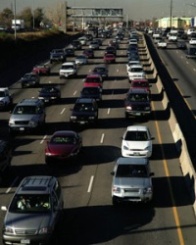Water: Polluted Runoff
Roads, Highways and Bridges - NPS Categories
Fact Sheets and Reports | Guidance Documents and Manuals | Information Resources and Centers | Special Programs
NPS Categories

Runoff-control measures can be installed at the time of road, highway and bridge construction to reduce runoff pollution during and after construction.
Runoff controls are essential to preventing polluted runoff from roads, highways and bridges from reaching surface waters. Erosion during and after construction of roads, highways and bridges can contribute large amounts of sediment and silt to runoff waters, which can deteriorate water quality and lead to fish kills and other ecological problems.
Heavy metals, oils, other toxic substances and debris from construction traffic and spillage can be absorbed by soil at construction sites and carried with runoff water to lakes, rivers and bays.
Runoff control measures can be installed at the time of road, highway and bridge construction to reduce runoff pollution both during and after construction. Such measures can effectively limit the entry of pollutants into surface waters and ground waters and protect their quality, fish habitats and public health. Pesticides and fertilizers used along roadway rights-of-way and adjoining land can pollute surface waters and ground water when they filter into the soil or are blown by wind from the area where they are applied.
Fact Sheets and Reports
- Erosion, Sediment and Runoff Control for Roads and Highways
This fact sheet includes an explanation of why runoff control measures are needed and best management practices that apply to construction and operation and maintenance. There is also a table that lists the sources of highway runoff pollution. (December 1995, EPA-841-F-95-008d) - Planning Considerations for Roads, Highways and Bridges
Planning considerations to help control runoff pollution from roads, highways and bridges are discussed in this fact sheet. (October 1995, EPA-841-F-95-008b)
Guidance Documents and Manuals
- Gravel Roads: Maintenance and Design Manual
The purpose of the manual is to provide clear and helpful information for doing a better job of maintaining gravel roads. It is designed for the benefit of elected officials, mangers and grader operators who are responsible for designing and maintaining gravel roads. - Environmentally Sensitive Maintenance for Dirt and Gravel Roads
This manual encourages environmentally sensitive maintenance of dirt and gravel roads and identifies ways to do so. It provides insight into using natural systems and innovative technologies to reduce erosion, sediment and dust pollution while more effectively and efficiently maintaining dirt and gravel roads and gives the users a "tool box" full of environmentally sensitive maintenance "tools" and practices. - Recommended Practices Manual: A Guideline for Maintenance and Service of Unpaved Roads
This is a manual of standard procedures, produced by Choctawhatchee, Pea and Yellow Rivers Watershed Management Authority, which describes and illustrates cost effective techniques and practices which can be used to enhance stability and maintenance of unpaved roadways while reducing sedimentation and improving the quality of surface waters. - Low-Volume Roads Engineering Best Management Practices Field Guide

This guide is intended to provide an overview of the key planning, location, design, construction and maintenance aspects of roads that can cause adverse environmental impacts and to list key ways to prevent those impacts. - Massachusetts Unpaved Roads BMP Manual (PDF) (106 pp, 1.8MB, About PDF)

This manual presents BMPs that can be used to improve water quality while enhancing the quality of unpaved roads. It is designed to be used by highway department supervisors, road crews and others engaged in maintaining private or public roadways. - Best Management Practices for Environmental Issues Related to Highway and Street Maintenance (PDF)
 (112 pp, 10MB, About PDF)
(112 pp, 10MB, About PDF)
This document is appropriate for state, county, city and local agencies. It is a compilation of practices likely to increase the environmental sensitivity of road maintenance work, including many practices that have become widely adopted and adapted. - Managing Your Environmental Responsibilities: A Planning Guide for Construction and Development (PDF) (255 pp, 998K, About PDF)
This document has been developed to provide a general overview of the federal environmental requirements for the construction industry. This document contains a general discussion on the common requirements pertaining to the construction industry. This document also contains a checklist to facilitate discussion and assignment of environmental responsibilities among the parties involved in a construction project. Additionally, self-audit checklists are provided in Part II of the document. (April 2005, EPA 305-B-04-003) - Stormwater Best Management Practice Design Guide (PDF) (194 pp, MB, About PDF)
This document focuses on ways to address water quality issues of best management practices (BMPs) in the absence of a complete regulatory framework. The second volume provides specific design guidance for a group of onsite BMP control practices that are referred to as vegetative biofilters and includes the following BMP control practices: grass swales, filter and buffer strips, and bioretention cells. (September 2004, EPA-600-R-04-121A)
Information Resources and Centers
- Road Maintenance Video Set
The "Road Maintenance Video Set" is a five-part video series developed for USDA Forest Service equipment operators. It focuses on environmentally sensitive ways of maintaining low volume roads. - US Forest Service's Water-Road Interaction Project Documents
This project examines the interactions between water and roads in terms of surface drainage, subsurface drainage and drainage crossings.
Special Programs
- Pollution Control Programs for Roads, Highways and Bridges
This fact sheet discusses the federal and state agencies that play a vital role in the management and regulation of nonpoint source pollution from the construction, operation and maintenance of roads, highways and bridges. (November 1995, EPA-841-F-95-008c)
